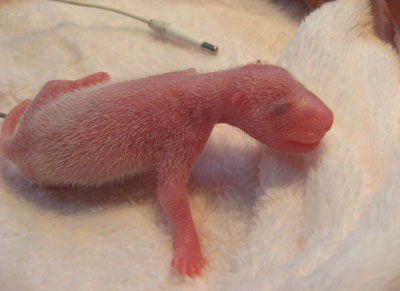|
Chubbiest panda cub born in SW China, doing well
(Xinhua)
Updated: 2006-08-08 06:26
The heaviest panda cub in the history of China's
artificial reproduction program born in southwest China on Monday is doing well,
said an official with the China Wolong Giant Panda Protection and Research
Center on Tuesday.
The cub's mother Zhang Ka, who was born in the wild
six years ago and becomes a mother for the first time, is also in good health,
said Li Desheng, deputy head of the Wolong center.

A giant panda cub. Photo taken on August
7. [Xinhua] |
Zhang Ka has begun nursing
the cub, a male panda, on herself, which is very important to the cub's
survival, Li said.
Li said, a panda cub is more likely to survive if it
is fed with his mother's foremilk. For this reason, researchers with the center
sent the newborn back to his mother seven hours later after his birth and guided
the mother panda to feed her baby.
The male cub was born at 10:39 a.m.
at the Wolong center and weighed 218 grams. It is also the second cub born this
year at the center.
A total of six panda cubs have been born so far this
year on the Chinese mainland with four others born at a giant panda research
center based in Chengdu, capital of Sichuan Province, on Sunday and Monday.
Zhang Ka also set a record for being in labor for about 34 hours.
Considering that Zhang Ka was exhausted after such a long delivery,
researchers took the cub away from the mom several minutes later his birth and
keep the cub in a special box, Li said.
Zhang Ka now can hold the cub in
her paw and shows some maternity little by little, said Li, the deputy head of
the Wolong center.
"She is doing quite well as a new mom," he said.
According to the Wolong center, Zhang Ka went in heat in early March and
she mated. Experts also performed artificial insemination to make sure she
conceived.
At 2:30 p.m. on Friday, Zhang Ka appeared to go into labour.
Experts at Wolong began a 24-hour watch. Just before 1 a.m. Sunday, the panda
mom's water broke, but exhausted Zhang Ka failed to deliver her cub.
By
early Monday morning experts decided to prepare to perform a Caesarean section,
but just a minute before the anesthetic was to be administered a tiny voice was
heard and the little pink creature was born.
The delivery room was
filled with the cheers and applause of staff.
China began to
artificially inseminate giant pandas in the 1960s but very few successful cases
were reported. Major breakthroughs began in the 1990s. Artificial insemination
produced nine baby pandas in 2000, 12 in 2001, 10 in 2002 and 15 in 2003. The
number rose to 25 last year, 21 of which survived.
Giant pandas show
little instinctive behavior in captivity, especially sexual desire.
Forestry
authority statistics show fewer than 10 percent of male giant pandas mate
naturally and fewer than 30 percent of females conceive naturally.
Female pandas normally become sexually mature at age four or five and
have only one chance at a pregnancy a year. After a gestation period of 160 days
they deliver one or two cubs.
The giant panda is one of the world's most
exotic and endangered species and is found only in China, where it is a national
treasure.Studies from the State Forestry Administration show there are over 180
giant pandas living in captivity on the Chinese mainland.
Experts had
previously estimated there were 1,590 giant pandas living in the wild in China,
but Chinese and British scientists announced in June that there could be as many
as 3,000 after a survey using a new method to profile DNA from giant panda
feces.
|
| |
|
| |
|
|
|
| Most Commented/Read Stories in 48 Hours |
|
|
|
|